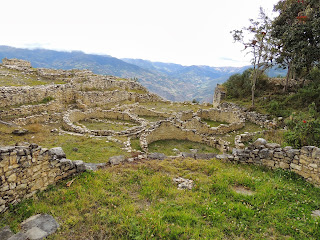 |
Detail at Huaca de la Luna
|
You are off to Peru because you are interested in the pre-Columbian civilisations? Oh, that will be the Incas, then? Actually, not. The Inca story is fascinating and tragic but they were only in power for a couple of hundred years before the Spanish destroyed their civilisation and stole - worse, melted down - all their gold and silver artefacts.
Fortunately, there is still plenty to see in the way of colossal buildings left by the Inca. But there is much, much more from the civilisations which preceded them. The Inca genius was in conquering other peoples and absorbing them and their skills, and in administering the huge Inca empire which resulted. Very like the Romans in all those respects.
But much of what we saw on this trip is evidence - massive evidence - of civilisations which existed thousands of years before the Inca. It is now known that Peru was inhabited, at least as long ago as Egypt, Sumeria and China, by peoples who erected enormous temples, colossal buildings and walled cities.
Much of this has been discovered in the past few years, even though it has been hiding "in plain sight" - "That's not a sandhill, it is a pyramid!" - and there is much more to come.
The picture above is from the Mochica complex of Huaca de la Luna, near Trujillo. The Mochica are famous for their wonderfully realistic portrait pottery and the beauty of their gold and silver jewellery. Of course much of this is missing, having been transported to Spain as ingots. But much remains and is being discovered.
Also near Trujillo is the colossal complex of Chan Chan. So far only one of many palaces has been uncovered, but it is one of the biggest buildings I have ever seen. So big that it was difficult to photograph. I borrowed this one from the Internet
Chan Chan was built by the ancient Chimu people.
 |
| Cabalitos de Tortora |
Not far from Chan Chan is the seaside resort of Huanchaca, where fishermen make and use these reed boats - caballitos de tortora - which have been used for centuries and which bear much resemblance to reed boats used on the Nile in ancient Egypt.
In the mountains is Cajamarca, where the Spanish tricked and killed Atahualpa, after he had paid an enormous ransom by having rooms filled with gold and silver. There is little by the way of ancient buildings to see in Cajamarca but it is a fascinating place. Why were these police, with shields, guns and teargas, ready for action in a town where the only activity that day seemed to be a student graduation ceremony and a peaceful march by mothers and children, demanding better school facilities?
 |
| Looking for Trouble? You came to the right place ... |
 |
Students getting ready to celebrate their degrees
|
And why is somebody taking my name in vain by opening this cafe in Cajamarca?
From Cajamarca we had a long, mountainous and very scenic drive to Leymabamba. Here are some pictures from that drive. More about Peruvian civilisations soon. Coming up next will be the Chachapoya. For now, enjoy the scenery. Don't forget you can enlarge the pictures after clicking on any one of them.











































